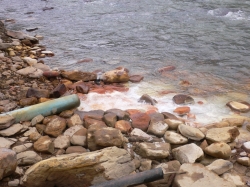WV and PA Discourage Processing Frackwater at Sewage Plants
From the Article by Leigh Krietsch Boerner, Chemical & Engineering News, March 18, 2013
When energy companies extract natural gas trapped deep underground, they’re left with water containing high levels of pollutants, including salts, benzene and barium. Sometimes the gas producers dispose of this contaminated water by sending it to wastewater treatment plants that deal with sewage and water from other industrial sources.
But a new study suggests that the plants can’t handle this water’s high levels of contaminants: Water flowing out of the plants into the environment still has elevated levels of the chemicals from natural gas production (Environ. Sci. Technol., DOI: 10.1021/es301411q).
In 2010, about 23% of U.S. natural gas production involved a process called hydraulic fracturing or fracking. Workers inject high volumes of water at high pressures into the ground to break shale rock formations and to release trapped natural gas. Up to 80% of that injected water returns to the surface, where it’s collected as wastewater.
Currently, companies deal with this leftover water by reusing it, injecting it into deep storage wells, or sending it through sewage treatment plants.
However, in May, 2011, the Pennsylvania Department of Environmental Protection asked that the state’s treatment plants voluntarily stop processing fracking wastewater. The request came in response to public concern over elevated bromide levels in the Pennsylvania Monongahela River watershed—an area with facilities that treat water from natural gas production. Scientists hadn’t definitively pinpointed fracking waste as the source of this pollution. In general, researchers haven’t studied how fracking wastewater affects the quality of water leaving sewage plants.
To learn more, Kyle J. Ferrar, a graduate student at the University of Pittsburgh, and his colleagues analyzed water from treatment facilities that initially processed fracking water and then later complied with the state’s recommendation. They took water samples from one private and two public facilities in Pennsylvania that treated water from the nearby Marcellus Shale region, the largest shale basin in the U.S. They collected samples both before and after the department’s request.
Using a variety of spectroscopic techniques, the team measured levels of chemicals found in gas production waste but aren’t typically present in other industrial wastewaters. Although levels of these chemicals varied widely among the three treatment plants, in general, concentrations dropped significantly after the plants stopped taking the fracking waste, Ferrar says. For example, at a municipal plant in Greene County, average barium concentrations fell from 5.99 to 0.14 mg/L.
But when the plants still handled the waste, levels of several of the chemicals exceeded drinking water standards set by the U.S. Environmental Protection Agency. At the Greene County plant, the levels of barium and strontium, two toxic metals found in fracking wastewater, were on average 5.99 and 48.3 mg/L, respectively. EPA drinking water standards for these metals are 2 and 4 mg/L, respectively.
Carl Kirby, a professor of geology at Bucknell University who studies the environmental impact of Marcellus Shale gas production, says the human health impact of elevated contaminant levels from processed fracking water is unclear, because the water the team sampled is not used directly as drinking water. However, he points out that fracking contaminants eventually could reach larger water systems used for drinking water, albeit at significantly diluted levels.
Ferrar agrees that there is no immediate public health concern over the pollutant levels. But he does worry about how the elevated levels affect aquatic ecosystems receiving water from treatment plants. He hopes researchers will study further the impact of disposing of produced waters via wastewater treatment plants.


{ 3 comments… read them below or add one }
A great research article. Very solid.
I recently read an article concerning frac/engineering by shale play. There are companies in the Bakken saying 45 frac stages, and a goal to increase the length of fracture for oil production.
In the Marcellus they have pushed it to 60 frac stages shortening distances between stages. In general this means a huge amount of freshwater and a larger amount of flowback to dispose of. I see a lot of desperate acts to dispose of this toxic water. These companies can tell investors that profits may increase but they are turning our country into a 3rd world environmental disaster. Is this what our citizens want? I hope not, it seems to be what we are getting.
That is the fitting blog for anybody who needs to search out about this topic. You present important facts. I will not argue with you (not that I truly would … HaHa). Important stuff, thank you!